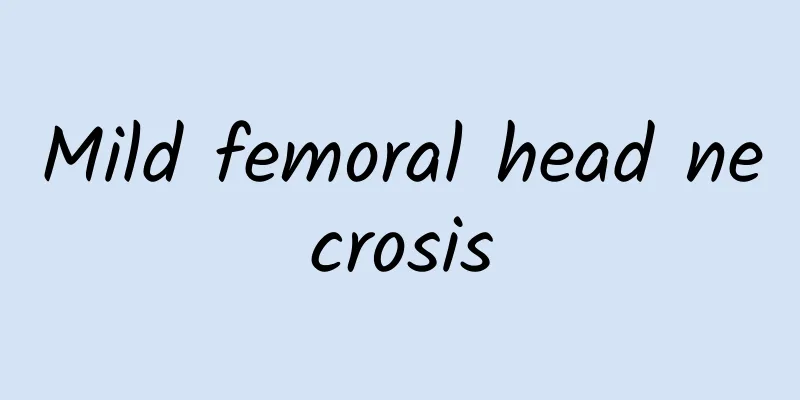Mild femoral head necrosis

| Femoral head necrosis is a common clinical disease. This disease has a direct impact on people's lives and even seriously affects people's normal ability to move. There are relevant judgments on the severity of femoral head necrosis clinically. The symptoms of early femoral head necrosis are relatively not obvious, but it should also be taken seriously and timely treatment measures should be taken. Mild femoral head necrosis may also evolve. 1. Femoral head necrosis is a pathological evolution process, which initially occurs in the weight-bearing area of the femoral head. Under the action of stress, the trabecular structure of the necrotic bone is damaged, namely microfracture, and then the damaged bone tissue is repaired. If the cause of bone necrosis is not eliminated and the repair is not complete, the injury-repair process will continue, leading to changes in the structure of the femoral head, collapse and deformation of the femoral head, joint inflammation, and functional impairment. Femoral head necrosis can certainly cause pain, joint movement and weight-bearing walking dysfunction, but people should not be influenced by the terrifying meaning of the words "bad and dead". After all, femoral head necrosis is localized and affects individual joints. It can be alleviated, subsided and healed on its own. Even if it is serious, it can eventually be remedied by artificial hip replacement and the ability to walk can be restored. 2. There are two main causes of femoral head necrosis: one is caused by poor healing of femoral neck fractures, in which the weight-bearing trabeculae in the femoral head turn to the weight-bearing area, reducing the load-bearing stress and causing stress damage. Therefore, necrosis always occurs after the patient's fracture heals and the patient walks with weight. The other is the bone tissue's own lesions, such as the most common osteonecrosis caused by chronic alcoholism or the use of glucocorticoids, and the impaired regenerative and repair ability of bone tissue. In addition, it also includes femoral head epiphysis necrosis of the femoral head germinal center during the development and growth period of children, also known as childhood femoral head necrosis and flat hip. 3. Mild femoral head necrosis can also be very serious. If not treated properly, severe necrosis will occur and cannot be cured. Therefore, mild femoral head necrosis requires active treatment, interventional surgery, or other surgical methods, and avoid smoking, drinking, and hormone use, as well as the indiscriminate use of Chinese or Western medicine based on hearsay. Try to use crutches at ordinary times to avoid excessive pressure on the femoral head. |
<<: What to do if the femoral head is broken
>>: Femoral head transplantation
Recommend
Can cranberries really cure gynecological diseases?
Cranberry is a relatively common fruit with relat...
Nine rules to follow for patients with hepatitis B virus (HBV) and hepatitis B virus (HBV)
Liver function test is an important clinical test...
What causes baby enteritis? This factor cannot be ignored
Pediatric enteritis is a very common pediatric di...
Red scalp with large dandruff
Redness of the scalp and large pieces of dandruff...
Taboos of soaking feet in pepper water
Many people in our lives have the habit of health...
What does blood gas analysis check?
A routine blood test can be used to analyze the h...
Can applying vitamin E on the face remove freckles?
Vitamin E can be taken orally, and it can help pr...
The baby stretched his legs straight and exerted all his strength
If the baby stretches his legs and exerts his who...
What kind of soup is better for replenishing blood and nourishing the skin? Which soups can replenish blood and nourish the skin?
Many people know that women are born to bleed, so...
Sheep Placenta Soft Capsules
When it comes to sheep placenta soft capsules, per...
How to quickly relieve pain from swollen gums
Swollen and painful gums are a common symptom in ...
Will my breasts become tender during the luteal phase?
Women become particularly cautious after getting ...
What causes headaches after drinking beer? How to stop the headaches after drinking
Nowadays, drinking is required for socializing in...
How to treat hydropneumothorax?
I don’t know if you are familiar with the disease...
Can sensorineural hearing loss be cured?
Deafness is a neurological disease that can be div...









